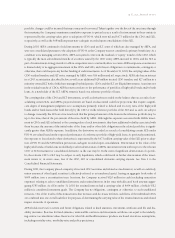American Express 2003 Annual Report Download - page 59
Download and view the complete annual report
Please find page 59 of the 2003 American Express annual report below. You can navigate through the pages in the report by either clicking on the pages listed below, or by using the keyword search tool below to find specific information within the annual report.
(p.57_axp_ financial review)
TRS also securitizes equipment lease receivables. At December 31, 2003 and 2002, the amount sold and outstanding to
third party investors was $138 million and $254 million, respectively. These sales resulted in a reduction of interest expense
and provisions for losses, as well as servicing revenue, all of which are insignificant to the Company’s results of operations.
Liquidity
The Company balances the trade-offs between having too much liquidity, which can be costly and limit financial flexibil-
ity, with having inadequate liquidity, which may result in financial distress during a liquidity crisis (see Contingent Liquidity
Planning section below). The Company considers various factors in determining its liquidity needs, such as economic and
financial market conditions, seasonality in business operations, growth in business segments, cost and availability of alter-
native liquidity sources, and credit rating agency considerations.
In 2003, TRS continued to strengthen its liquidity position by reducing its reliance on short-term debt through extension
of its debt maturities. Short-term debt on a GAAP basis as a percentage of total debt declined to 57% at December 31, 2003
from 59% at December 31, 2002. Additionally, short-term debt on a managed basis as a percentage of total debt declined
to 38% at December 31, 2003 from 40% at December 31, 2002.
TRS estimates it will have liquidity requirements of approximately $8.7 billion within the next year related to the maturity
of long-term debt obligations. These requirements include $3.8 billion related to certain securitization transactions that will
enter their scheduled amortization period. In addition, TRS expects to maintain net short-term debt balances of approxi-
mately $14 billion over the period. TRS believes that its funding plan is adequate to meet these liquidity requirements.
TRS believes that its available liquidity provides sufficient funding to meet normal operating needs at all times. In addition,
alternative liquidity sources are available, mainly in the form of the liquidity portfolio, securitizations and committed bank
credit facilities, to provide uninterrupted funding over a twelve-month period should access to unsecured debt sources
become impaired.
Liquidity Portfolio
During the normal course of business, funding activities may raise more proceeds than are necessary for immediate fund-
ing needs. These amounts are invested principally in overnight, highly liquid instruments. In addition, in the fourth quar-
ter of 2003, the Company began a program to develop a liquidity portfolio in which proceeds raised from such borrowings
are invested in two to three year U.S. Treasury securities. At December 31, 2003, the Company held $800 million in two
year U.S. Treasury notes under this program. This program was increased to approximately $4 billion in the first quarter
of 2004.
The invested amounts of the liquidity portfolio provide back-up liquidity, primarily for the commercial paper program at
Credco, and also flexibility for other short-term funding programs at Centurion Bank. U.S. Treasury securities are the high-
est credit quality and most liquid of investment instruments available. The Company can easily sell these securities or enter
into sale/repurchase agreements to immediately raise cash proceeds to meet liquidity needs.
From time to time, either Credco or Centurion Bank may increase its liquidity portfolio in order to pre-refund maturing
debt obligations when financial market conditions are favorable. These levels are monitored and adjusted when necessary
to maintain short-term liquidity needs in response to seasonal or changing business conditions.
























